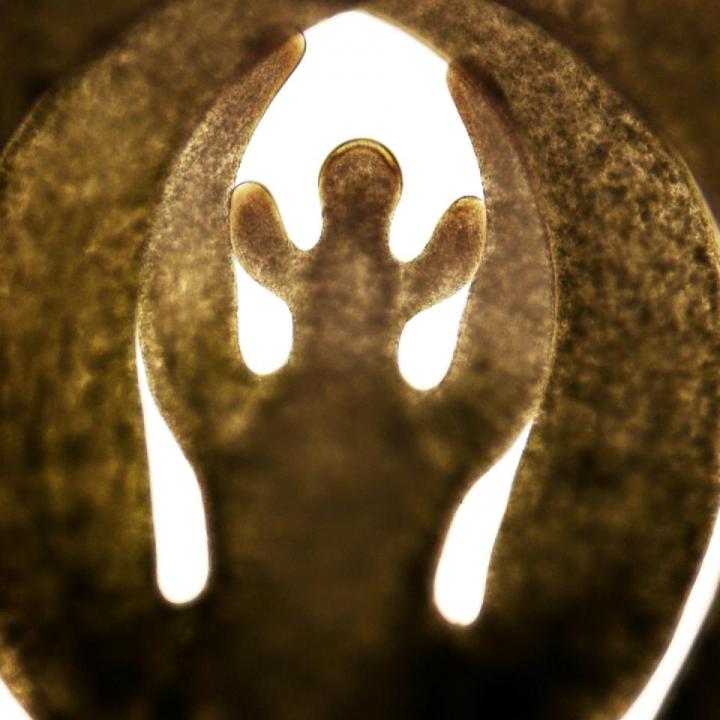Structure of world's largest single cell is reflected at the molecular level

This is the frond apex of Caulerpa taxifolia, a single celled organism, producing leaf-like pinnules. Without multicellularity, Caulerpa independently evolved a structure and form similar to land plants. Credit: Donald Danforth Plant Science Center
“Caulerpa is a unique organism,” said Chitwood. “It's a member of the green algae, which are plants. Remarkably, it's a single cell that can grow to a length of six to twelve inches. It independently evolved a form that resembles the organs of land plants. A stolon runs along the surface that the cell is growing on and from the stolon arise leaf-like fronds, and root-like holdfasts, which anchor the cell and absorb phosphorous from the substrate. All of these structures are just one cell.”
“For many years, I've been interested in structure and form in plants, especially in tomato, which is the land plant that I've studied most,” Chitwood continued. “As you might imagine, finding out what determines structure and form in a complex tomato plant is a challenging goal. It's critical to know how plants grow and develop to provide more tools to improve them and ultimately to make food production more reliable. Multicellularity is an important prerequisite that enables complex architectures in crops. Yet Caulerpa is a plant, too, and independently evolved a land plant-like body plan, but without multicellularity and as a single cell. How does that happen?”
Chitwood and his group reasoned that the structure of Caulerpa might be reflected in the RNA's present in various parts of the cell. (RNA's are the molecular products found when genes are expressed or “turned on.”) For example, the frond part of the cell might show different RNA's from the holdfast part of the cell. When performed on Caulerpa, this type of analysis would also provide insights into the distributions of RNA's within single cells, a feat normally difficult to achieve because cells in multicellular organisms are so small.
“The result turned out to be even more interesting than we'd hoped,” said Chitwood. “Not only do different parts of the Caulerpa cell show distinctly different RNA's, but there is also some correlation between RNA's that are expressed together within different parts of the Caulerpa cell with those expressed together in the multicellular organs of tomato. Even though the lineage that Caulerpa belongs to probably separated from that giving rise to land plants more than 500 million years ago, in many ways Caulerpa displays patterns of RNA accumulation shared with land plants today.”
“Our work on Caulerpa has given me and my team a whole new way of thinking about plant structure and development,” Chitwood continued enthusiastically. “It's clear that the basic form we associate with land plants can arise with and without multicellularity. In fact, higher plant cells are connected to each other by means of channels called plasmodesmata, and it has been argued that multicellular land plants exhibit properties similar to single-celled organisms like Caulerpa.
What if we could really think of higher plants, like tomato, as one cell instead of multitudes? This idea of thinking of multicellular land plants, like tomato, and giant single-celled algae, like Caulerpa, similarly is supported by our results that demonstrate a shared pattern of RNA accumulation. Frankly, our results have caused us to think about plant structure from an entirely different perspective, which is the most important outcome from this research.”
About The Donald Danforth Plant Science Center
Founded in 1998, the Donald Danforth Plant Science Center is a not-for-profit research institute with a mission to improve the human condition through plant science. Research aims to feed the hungry and improve human health, preserve and renew the environment and position the St. Louis region as a world center for plant science. The Center's work is funded through competitive grants and contract revenue from many sources, including the National Institutes of Health, U.S. Department of Energy, National Science Foundation, U.S. Department of Agriculture, U.S. Agency for International Development, the Bill & Melinda Gates and Howard G. Buffett Foundations.
To keep up to date with Danforth Center's current operations and areas of research, please visit, http://www.
Media Contact
All latest news from the category: Life Sciences and Chemistry
Articles and reports from the Life Sciences and chemistry area deal with applied and basic research into modern biology, chemistry and human medicine.
Valuable information can be found on a range of life sciences fields including bacteriology, biochemistry, bionics, bioinformatics, biophysics, biotechnology, genetics, geobotany, human biology, marine biology, microbiology, molecular biology, cellular biology, zoology, bioinorganic chemistry, microchemistry and environmental chemistry.
Newest articles

NASA: Mystery of life’s handedness deepens
The mystery of why life uses molecules with specific orientations has deepened with a NASA-funded discovery that RNA — a key molecule thought to have potentially held the instructions for…

What are the effects of historic lithium mining on water quality?
Study reveals low levels of common contaminants but high levels of other elements in waters associated with an abandoned lithium mine. Lithium ore and mining waste from a historic lithium…

Quantum-inspired design boosts efficiency of heat-to-electricity conversion
Rice engineers take unconventional route to improving thermophotovoltaic systems. Researchers at Rice University have found a new way to improve a key element of thermophotovoltaic (TPV) systems, which convert heat…



